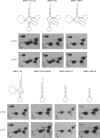Characterization of two homologous 2'-O-methyltransferases showing different specificities for their tRNA substrates
- PMID: 24951554
- PMCID: PMC4105751
- DOI: 10.1261/rna.044503.114
Characterization of two homologous 2'-O-methyltransferases showing different specificities for their tRNA substrates
Abstract
The 2'-O-methylation of the nucleoside at position 32 of tRNA is found in organisms belonging to the three domains of life. Unrelated enzymes catalyzing this modification in Bacteria (TrmJ) and Eukarya (Trm7) have already been identified, but until now, no information is available for the archaeal enzyme. In this work we have identified the methyltransferase of the archaeon Sulfolobus acidocaldarius responsible for the 2'-O-methylation at position 32. This enzyme is a homolog of the bacterial TrmJ. Remarkably, both enzymes have different specificities for the nature of the nucleoside at position 32. While the four canonical nucleosides are substrates of the Escherichia coli enzyme, the archaeal TrmJ can only methylate the ribose of a cytidine. Moreover, the two enzymes recognize their tRNA substrates in a different way. We have solved the crystal structure of the catalytic domain of both enzymes to gain better understanding of these differences at a molecular level.
Keywords: SPOUT; methyltransferase; modified nucleosides; tRNA.
© 2014 Somme et al.; Published by Cold Spring Harbor Laboratory Press for the RNA Society.
Figures








References
-
- Anantharaman V, Koonin EV, Aravind L 2002. SPOUT: a class of methyltransferases that includes spoU and trmD RNA methylase superfamilies, and novel superfamilies of predicted prokaryotic RNA methylases. J Mol Microbiol Biotechnol 4: 71–75 - PubMed
-
- Auffinger P, Westhof E 1999. Singly and bifurcated hydrogen-bonded base-pairs in tRNA anticodon hairpins and ribozymes. J Mol Biol 292: 467–483 - PubMed
MeSH terms
Substances
LinkOut - more resources
Full Text Sources
Other Literature Sources
Molecular Biology Databases
